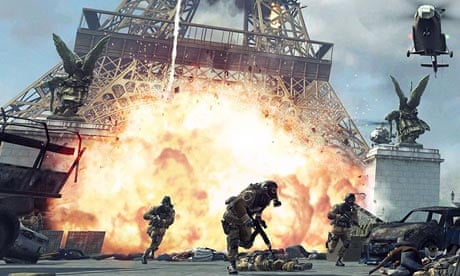The British military has had to radically improve some of its simulated training war games to keep the attention of recruits who have grown up in the Playstation and Xbox generation, a Ministry of Defence scientist has admitted.
Troops are so used to playing high-quality commercial games set in combat zones that they tend to lose concentration unless the MoD simulations look equally realistic. This has become an important issue at the MoD, which is increasingly turning to digital simulations to help prepare soldiers for duty.
Thousands of troops sent to Afghanistan have been trained on Virtual Battlespace2, a spin-off from a commercial game that can, for instance, test their responses when they come under mortar attack from insurgents.
Though the military stresses that these games only supplement traditional methods, it reflects the way technology is transforming military training. With budgets being squeezed across the MoD, simulations are also a comparatively cheap way of giving troops a "virtual'' taste of what they might come up against in a warzone.
Another idea involves issuing RAF trainee pilots with tablet computers such as iPads, to save the cost – and weight – of printing bulky flight manuals that need to be regularly updated and cost £1,000 a student.
The scientists and engineers at MoD's Defence Science and Technology Laboratory in Portsdown, Hampshire, are at the heart of the developments.
Andrew Poulter, the technical team leader, said the military was trying to keep up with the advances that have helped turned computer gaming into a hugely lucrative global industry. Bestsellers such as Battlefield 3, Killzone 3 and the Call of Duty series have taken this genre of video games, known as "first-person shooters'', to a new level.
"Back in the 1980s and 1990s, defence was far out in front in terms of quality of simulation," said Poulter. "Military-built simulators were state of the art. But now, for £50, you can buy a commercial game that will be far more realistic than the sorts of tools we were using. The truth is, the total spending on games development across the industry will be greater than spending on defence."
Poulter is in charge of Project Kite (knowledge information test environment), which has been tasked with putting the MoD back in the forefront of simulation training, in part by buying-in technology from the big gaming companies.
The key to successful virtual training is for the simulation to be realistic enough for people to be properly "immersed'' in what they are doing.
"Certainly, there is a level of computer games experience in recruits. So the plots have to be realistic and the image generation has to be high quality. A lot of the older systems can be very clunky. If you put someone behind a block display, it is harder for them to be completely immersed." But though the commercial games "may look graphically beautiful, they have to be entertaining rather than realistic".
Poulter and his nine-strong team will adapt the software so that the weapons perform as they would in combat "The weapons need to be credible. If they fire a rifle and the bullet travels three and a half miles, then that is not right. If they are steering a vehicle, then that has to be right too. Realism is more important than entertainment. Levels of immersion are very important."
The MoD is using a variety of simulations, from drills to put out a fire in an aircraft to what to do if a vehicle in a convoy gets hit by a roadside bomb.
There are specific Afghanistan simulations, designed to give troops an idea of the tough environment they will find in one of the small forward operating bases in Helmand, and the drills they need to use if they come under attack.
Putting training simulations on tablet computers could be the next big shift in training. It would allow sailors, soldiers and aircrews to practise techniques wherever they wanted to. "Virtual Battlespace is quite good fun, and we want trainees to want to do training," said Poulter.
"It is certainly a lot more fun than going through lists of checks and box-ticking.
"We want them to think 'I would quite like to do a bit more of that kind of thing'. So they might spend 10 minutes [on a simulation] after reading papers in the morning, or in their spare time."
Cost has also become a pressing issue. "If they have already learned some core skills in a simulation, there is less to learn during live training, which is much more expensive and may involve aircraft, tanks, and live round explosions."
Poulter said a commander who came back from Afghanistan told him that two soldiers in his unit had drilled themselves so much on Virtual Battlespace2, he was sure the training had saved their lives when they came under fire. "It has been invaluable. It is being taken seriously. It's not just a game," said Poulter.
